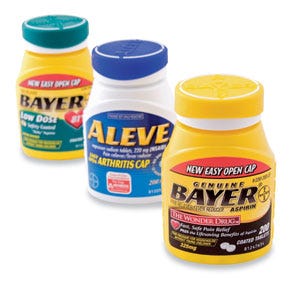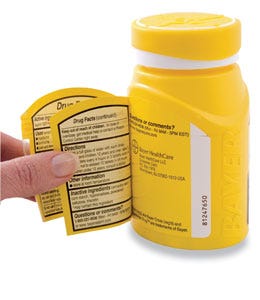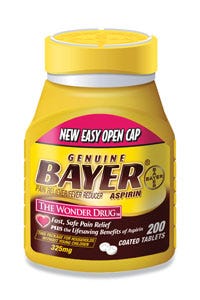January 30, 2014

Bayer Bottles 1
No other drug product enjoys such widespread use as aspirin. There are few other medicines with such a long history. Aspirin's status as wonder drug remains pretty much unchanged today, as the stress-filled world we live in grows more stressful.Twice as many people choose aspirin over the personal computer as an invention they couldn't live without, in a national survey on inventions conducted by Massachusetts Institute of Technology. Aspirin's powerful pain-fighting qualities have been known since ancient times when the Greeks recorded the use of willow bark as a fever fighter. The leaves and bark of the willow tree contain a substance called salicin, a naturally occurring compound similar to acetylsalicylic acid, the chemical name for aspirin.
Today, Bayer Consumer Care is introducing its products in new packaging with several points of difference. Designed for Genuine Bayer® aspirin, Bayer Low Dose aspirin and Aleve® products, not only has the shape of the bottles been changed to a larger, sleek HDPE oval, the bottles are now topped with a newly designed, easy-open/easy-grip cap covered with a soft-touch, rubber-like thermoplastic elastomer (TPE), color-coded to match the graphics for each SKU. The TPE helps improve the user experience, according to Bayer. It's also an attractive feature for the aging population because the soft rubber-like material covering the outer part of the cap makes it easier to hold and remove.
Even more noteworthy for the product category, however, is what is described by Alexandra Borchard, associate communications manager at Morristown, NJ-based Bayer Healthcare, Consumer Care: “This is Bayer Consumer Care's first venture into cartonless bottles in the analgesics category.” Affirms Guido Schmitz, senior associate director, global innovation and new technology, Bayer Consumer Care Div., Bayer Healthcare, “We were inspired to develop a package that was worthy of our Wonder Drug™ that was different and more user-friendly than any other medicine bottle. There was also an opportunity to minimize packaging waste associated with cartons. At the same time, this was an opportunity for Aleve® to explore new packaging design options.”
Bayer's main objective, Schmitz says, was to create an easy-open bottle for Aleve's core user, the arthritis sufferer. 
Bayer Bottles 2
“This is a first for our category. It's very cool and different. In fact, it's now a sought-after concept by others in the category. We're very proud of the concept.”The packaging structure is identical for both Bayer aspirin and Aleve. Each bottle incorporates a raised Bayer (or Aleve) logo grip on opposing sides. Graphics, however, including color and text style, are different for each brand. The Bayer aspirin bottle labels feature the brand's iconic bright yellow, red and brown or green colors and bright yellow bottles with yellow or green caps. The Aleve bottles are opaque white with a blue graphic scheme and blue and white caps.
The same container configuration is being used for Bayer Genuine 325-mg aspirin in 100-, 200- and 300-count bottles; Bayer Low Dose 81 in 120-, 200- and 300-count bottles; and Aleve in 40-, 100- and 200-count container sizes. Aleve's 40-count gelcap SKU is still being merchandised with an outer carton. “The smaller count bottle didn't work well outside of a carton, with the shelf-pushing trays used by the retailers,” explains Schmitz “Therefore, we needed to package it inside a carton.
Shipped into retail stores in April 2009, the bottles and closures are supplied by Berry Plastics Corp. The oval bottles feature resealable extended-content labels from CCL Label that present drug facts and consumer information.
The cartonless approach minimizes packaging waste and energy use while optimizing retail shelf space, says Schmitz. “The cartonless format gives us more flexibility for editing the drug facts and contact information on an as-needed basis,” he says.
The time was right
Bayer's packaging staff worked for two years developing various concepts with the help of design firm Berndt Group. The large oval bottle design is based on a new platform that Bayer says it can customize for its other products.
“These factors are all helping to differentiate Bayer Aspirin and Aleve products on shelf,” Schmitz adds. The packaging team considered several key factors as we worked to design new bottles, that was right for the business and right for our consumers. One was consumer benefit—will it be functional and easy to use? Another was brand identity—how will the look and feel represent our brand? And another was point of sale—what impact will it have on-shelf? The final factor was sustainability— eliminating the use of unnecessary packaging. Based on these, the team developed various concepts with Berndt Group, Schmitz says. “As a result of our new design, there is immediate impact on shelf,” he adds.
Berry Plastics began working on the project in late 2007; the bottle design, development and project management took place at its Lancaster, PA facility, which is close to Bayer Healthcare's headquarters and manufacturing sites.
The three bottle sizes are all injection/blow-molded and flame-treated at Berry Plastic's Cranbury, NJ facility and the caps are made at its plant in Ahoskie, NC.
Capping it off

Bayer Bottles 3
In Ahoksie, Berry produces the cap using a bi-injection-molding process with a rotating stack mold and PP and TPE materials. The cap was refined for manufacturability and child-resistance, according to Berry's Heather Moore, account executive, Health Care and Nutritional Sales. The outer TPE closure is made using a two-shot mold from MGS using a secondary injection unit, and the TPE material, which is made by GLS Thermoplastic Elastomers. The inner PP cap is a stock child-resistant CR-III closure in 33- and 45-mm sizes. Debossed with the criss-cross Bayer logo that's imprinted on the aspirin tablets themselves, while the Aleve cap is debossed with a single Aleve logo without criss-crossing. Tamper-evidence is provided to the bottle opening with a foil/pulp induction seal printed with “Bayer HealthCare” in black lettering To dispense the tablets, the user first breaks the seal.The filled bottles had to be designed to stack well on top of one another on retail shelves and the closure colors had to be repeatable and accurate.
“By managing the design of the bottle and the closure, we made some modifications to the overall design to better enhance the child-resistance,” says Moore. “The second challenge was to handle the closures through secondary processes and into shipping cases. Our internal automation engineers, plant personnel and secondary equipment suppliers were critical to finding solutions.”
Adds Schmitz, “We wanted to include our signature Bayer cross logo, and the top of the cap offered another opportunity to brand the bottle.”
No carton, no problem
Foregoing the carton has its advantages, Schmitz emphasizes. Reduced packaging results in less material and lower costs overall. “By eliminating the carton, we have a more environmentally sustainable product and we're reducing energy that would otherwise be needed to carton the product,” he says. “Retailers gain shelf space because the packaging is minimized. The orientation is shifted from horizontal to vertical [display], resulting in valuable space that can be utilized by the retailers. Most importantly, this is just the beginning for Bayer Consumer Care. We plan to apply this innovative packaging to some of our other consumer products going forward.”
Without a carton Schmitz says that the company doesn't need to worry as much about carton supplies. “Because of the elimination of the carton (for most of the bottle sizes), we have a more environmentally sustainable product. The extended-text back-panel labels also provide (product-copy) flexibility.”
Permanently affixed to the backs of each bottle, the multipanel labels include a large bar code on the front page and three additional pages of product details and Drug Facts. They can be opened and resealed to the bottles numerous times. The front-panel bottle labels are printed with an admonishment reading, “This package for households without young children.”
New bottling line
The bottles are filled at Bayer Consumer Care's production facility in Myerstown, PA on a new packaging line that Schmitz says was installed to replace an older line that would add more capacity. “Based on the projected volumes as a result of this initiative, we decided to dedicate the new line to the Aleve and Bayer Aspirin products.”
Customized with new packaging equipment that can handle the oval bottles, the line was installed in December 2008. Bayer's packaging team also had to select equipment that could accommodate the TPE caps as well as cartonless and cartoned containers. At the head of the versatile line is an Omega unscrambler with an integrated desiccant feeder and an Aylward filler, followed by an IMA Nova cottoner, a capper from Pneumatic Scale, an Enercon induction sealer to seal the the foil membrane from the cap to the mouth of the bottle, an NJM/CLI retorquing unit, a multipanel label applicator from Weiler and an Oystar cartoner for the 40-count bottles requiring a carton. The bottles are grouped and shrink-bundled for shipment, so Bayer also installed a horizontal fifth-panel orienter and shrink-bundling systems from Omega, and a case packer from Schneider Packaging Equipment.
Easy pill to swallow
It's not a hard pill to swallow when the results of a packaging redesign go this well, says Matt Glenn, manager of customer marketing at Bayer Consumer Care. “Retailers are responding favorably. They have commented on Bayer's innovative approach to packaging and have even mentioned duplicating the packaging for their private-label bottles. In addition to being innovative, the packaging is differentiating our products on shelf.”
Still, Glenn says, the company is presently testing the new, larger bottles with consumers to determine how consumers perceive the new packaging and cap.
“We're checking to see if they like it, if they think it's different from base packaging, etc.,” he says. “But since the packaging was fully implemented in the market in July, it's still too early to discuss its impact on sales.”
But it's allowing Bayer to use newer machines at higher throughput speeds with less production time, less warehouse stock and less carton materials, says Schmitz.
“Collectively, these can help to positively impact our carbon footprint,” he says.
More information is available: |
Berndt Group, 410/889-5854. http://berndtgroup.com |
Berry Plastics Corp., 812/424-2904. www.berryplastics.com |
CCL Label, 203/926-1253. www.ccllabel.com |
Aylward Enterprises LLC, 252/633-5757. www.aylward-usa.com |
Enercon Industries Corp., 262/255-6070. www.enerconind.com |
IMA Nova, 800/851-1518. www.imanova.com |
GLS Thermoplastic Elastomers, 800/457-8777. www.glstpes.com |
MGS Mfg. Group, Inc., 262/255-5790. www.mgstech.com |
NJM/CLI Packaging Systems Intl., 800/432-2990. www.njmcli.com |
Omega Design Corp., 800/346-0191. www.omegadesign.com |
Oystar USA Inc., 732/536-8770. www.oystarusa.com |
Pneumatic Scale, 330/923 0491. www.pneumaticscale.com |
Schneider Packaging Equipment Co. Inc., 315/676-3035. www.schneiderequip.com |
Weiler Labeling Systems, 856/273-3377. www.weilerls.com |
About the Author(s)
You May Also Like


